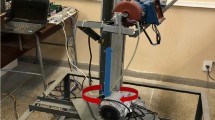Abstract
Exechon machines are a new type of parallel kinematic machines, which have been proven experimentally to be competitive in terms of accuracy, reliability, and operation speed. The proven performance is partially contributed by its unique layout of three prismatic legs; its kinematic structure is overconstrained. Higher accuracy is a primary goal for the use of an Exechon machine; accuracy relies on system stiffness and rigidity. However, the works on the stiffness analysis of Exechon machines has been limited to some numerical results from finite element analysis; no correlation between the motions and stiffness change has been studied systematically. To gain a thorough understanding of the impact of the overconstraints on system stiffness, the kinetostatic method is used for stiffness analysis. Jacobian matrices of kinematics have been derived, and they are used to develop the system stiffness model of the machine. The Exechon X700 model has been used as a case study to illustrate the process of stiffness analysis. The stiffness model is established and quantifiable comparison has been made between simulation and test data to verify the effectiveness of the stiffness model. The developed stiffness model can be applied to optimize machine structure or trajectory planning based on the specified task.
Similar content being viewed by others
References
Griffis M, Duffy J (1993) Global stiffness modelling of a class of simple compliant couplings. Mech Mach Theory 28(2):207–224
Ciblak N, Lipkin H (1994) Asymmetric Cartesian stiffness for the modelling of compliant robotic systems. Proc ASME Conf Robot Kinemat Dyn Contr 72:197–204
Alici G, Shirinzadeh B (2005) Enhanced stiffness modelling, identification and characterization for robot manipulators. IEEE Trans Robot 21(4):554–564
Xi F, Zhang D, Mechefske CM, Lang SYT (2004) Global kinetostatic modelling of tripod-based parallel kinematic machine. Mech Mach Theory 39:357–377
Zhang D, Xi F, Mechedske CM, Lang SYT (2004) Analysis of parallel kinematic machine with kinematic modelling method. Robot Comput Integr Manuf 20:151–165
Moaveni S (2003) Finite element analysis: theory and application with ANSYS. Pearson, Upper Saddle River, NJ. ISBN 0-13-111202-3
Ramachandran S, Nagarajan T, Prasad NS (1992) A finite element approach to the design and dynamic analysis of platform type robot manipulators. Finite Elem Anal Des 10:335–350
Clinton CM, Zhang G, Wavering AJ (1997) Stiffness modeling of a Stewart-platform-based milling machine. Transact North Am Manuf Res Inst SM 25:335–340
Huang T, Zhao X, Whitehouse (2002) Stiffness estimation of a tripod-based parallel kinematic machine. IEEE Trans Robot Autom 18(1):50–58
Gosselin C (1990) Stiffness mapping for parallel manipulators. IEEE Trans Robot Autom 6(3):377–382
Majou F, Wenger P, Chablat D (2001) The design of parallel kinematic machine tools using kinetostatic performance criteria. The Proc. 3rd International Conference on Metal Cutting, Metz, France
Tsai L-W, Joshi S (2001) Comparison study of architectures of four 3 degree-of-freedom translational parallel manipulators. Proceedings of the 2001 I.E. International Conference on Robotics and Automation, Seoul, Korea, May 21–28, pp. 1283–1288
Goldsmith PB (2002) Kinematics and stiffness of a symmetrical 3-UPU translational parallel manipulator. Proceedings of the 2002 I.E. International Conference on Robotics and Automation, Washington, DC, USA, pp. 4102–4107
Muller A, Maiber P (2001) Kinematic and dynamic properties of parallel manipulators. Multibod Sys Dyn 5:223–249
Zhang D, Gosselin CM (2002) Parallel kinematic machine design with kinetostatic model. Robotia 20:429–438
Zhang D, Gosselin CM (2002) Kinetostatic analysis and design optimization of the tricept machine tool family. J Manuf Sci Eng 124:725–733
Bi ZM, Lang SYT, Zhang D (2005) Stiffness analysis of a tripod with a passive link. Am Soc Mech Eng Dyn Syst Contr Divi-DSC 74(2B):1665–1671
EI-Khasawneh BS, Ferreira PM (1999) Computation of stiffness and stiffness bounds for parallel link manipulators. Int J Mach Tools Manuf 39:321–342
Bi ZM, Lang SYT, Verner M, Orban P (2008) Development of reconfigurable machines. Adv Manuf Technol 39(11–12):1227–1251
NeuMann K-E (2008) Adaptive in-jig high load Exechon machining & assembly technology. SAE International, Paper No. 08AMT-0044
NeuMann K-E (2011) IEEE/IFR invention & entrepreneurship award 2011. http://www.ifr.org/uploads/media/01_IERA_application_neumann.pdf
Bi ZM, Jin Y (2011) Kinematics modelling of Exechon parallel kinematic machine. Robot Comput Integr Manuf 27(1):186–193
Glenn Murray (2001) Rotation about an arbitrary axis in 3 dimensions, http://inside.mines.edu/~gmurray/ArbitraryAxisRotation/
Author information
Authors and Affiliations
Corresponding author
Rights and permissions
About this article
Cite this article
Bi, Z.M. Kinetostatic modeling of Exechon parallel kinematic machine for stiffness analysis. Int J Adv Manuf Technol 71, 325–335 (2014). https://doi.org/10.1007/s00170-013-5482-z
Received:
Accepted:
Published:
Issue Date:
DOI: https://doi.org/10.1007/s00170-013-5482-z




